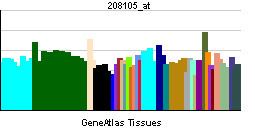Entrez 2696 | Ensembl ENSG00000010310 | |
 | ||
Aliases GIPR, PGQTL2, gastric inhibitory polypeptide receptor External IDs OMIM: 137241 MGI: 1352753 HomoloGene: 20081 GeneCards: GIPR | ||
The gastric inhibitory polypeptide receptor (GIP-R) also known as the glucose-dependent insulinotropic polypeptide receptor is a protein that in humans is encoded by the GIPR gene. The GIP-R is seven-transmembrane proteins found on beta-cells in the pancreas.
Function
Gastric inhibitory polypeptide (GIP), also called glucose-dependent insulinotropic polypeptide, is a 42-amino acid polypeptide synthesized by K cells of the duodenum and small intestine. It was originally identified as an activity in gut extracts that inhibited gastric acid secretion and gastrin release, but subsequently was demonstrated to stimulate insulin release potently in the presence of elevated glucose. The insulinotropic effect on pancreatic islet beta-cells was then recognized to be the principal physiologic action of GIP. Together with glucagon-like peptide-1, GIP is largely responsible for the secretion of insulin after eating. It is involved in several other facets of the anabolic response.
